For this we used two small armies of 12 elements a side (the sort of game you might have in DBA for example).
Greeks used 3 units each of 4 bases;
2 units of Spartans classed as; heavy infantry, armed with long spear, steady, veterans, with the phalanx and stubborn special rules.
1 unit of allied Greeks; heavy infantry, armed with long spear, average, seasoned, with the phalanx special rule
Gauls again 3 units of 4 bases but no reason to do it this way, they equally could have been 12 units, each of a single base.
3 units of Gauls; medium infantry in loose formation, javelins, sword, average, seasoned, with the wild charge special rule.
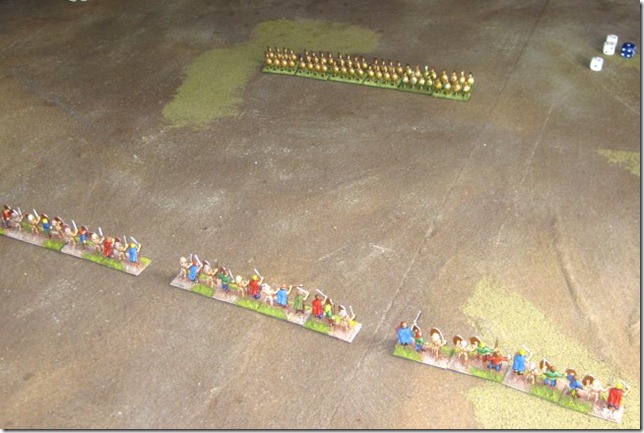
both armies deploy, the Greeks choose a double line formation to get the maximum fighting power from their long spears. The Gauls gaining no advantage from fighting more than one rank deep, deploy in single lines and overlap the Greeks line.
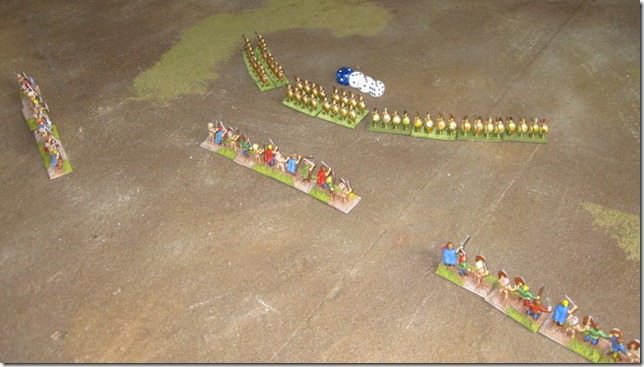
Both sides advance, with the allied Greek hoplites expanding into a single line to prevent the Gauls getting round the Greek flank.
In the centre a unit of Spartans declare a charge, roll; 5, 3, 3 and 2. They elect to discard the 2 (regulars roll 4 dice and chose one die to discard), so the score is 11, they are fine and charge.
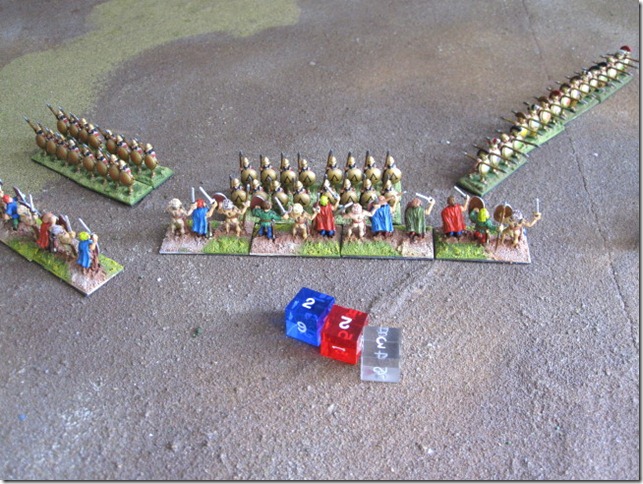
The Gauls roll miserable 7 (warriors simply roll 3 dice and use that score for their morale), become Shaken and have to take the charge at the halt.

On the Gallic left, a unit moves up and throws javelins at the second unit of Spartans. At short range (the only range close order troops can throw javelins) they need four or less to get a kill. They get 3 kills (see above) not quite enough (four hits needed to remove a base) to remove a base.

After taking casualties from shooting, the Spartans take a morale test, roll 4, 2, 2, 1 and discard the one. On a score of 8 the Spartans are happy. In the centre the Gauls inflict a single casualty on the charging Spartans, but that did not worry them either.
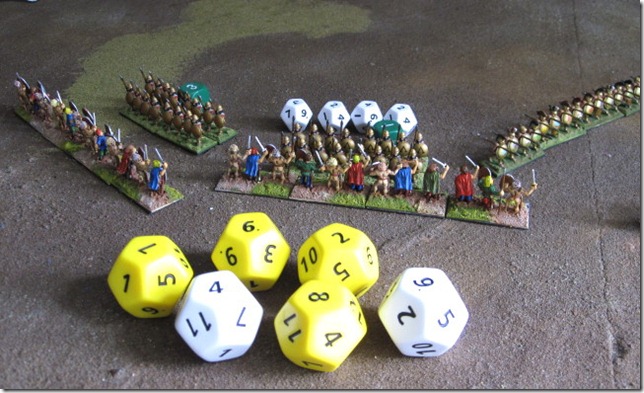
In the combat phase 2 bases of Spartans score a hit with every dice rolled (needing 7 or less to score a hit) the Gauls have a longer frontage, so fight back with 3 bases (6 dice) needing 2 or less to roll a hit and score one hit. That means that the Gauls lose and lose by 4 hits to 1.
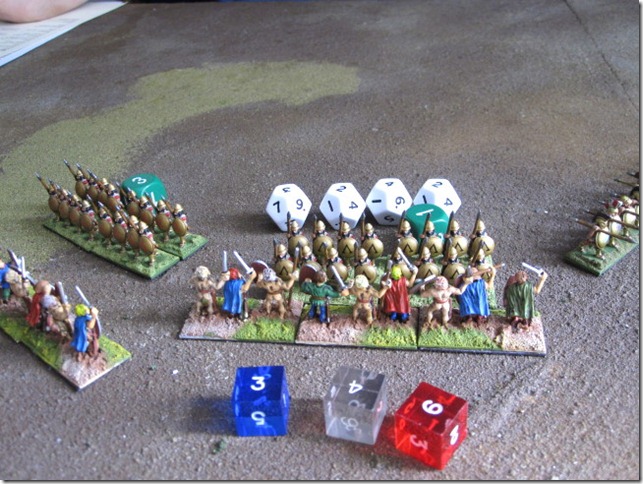
Rolling a good score of 13, the Gauls modified morale total is 4 as they were Shaken and lost the melee by 4 to 1, so they Retreat.
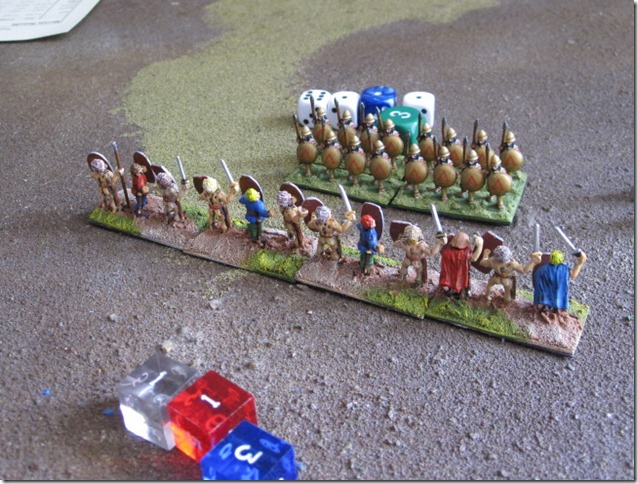
Now the Gauls on the left are charged by the other Spartan unit. The Spartans roll 8 (discarding one of the ones) and are fine, the Gauls roll 5 (modified down to 4 because of their retreating friends) and Retreat, taking them out of the charge range of the Spartans who merely move forward.
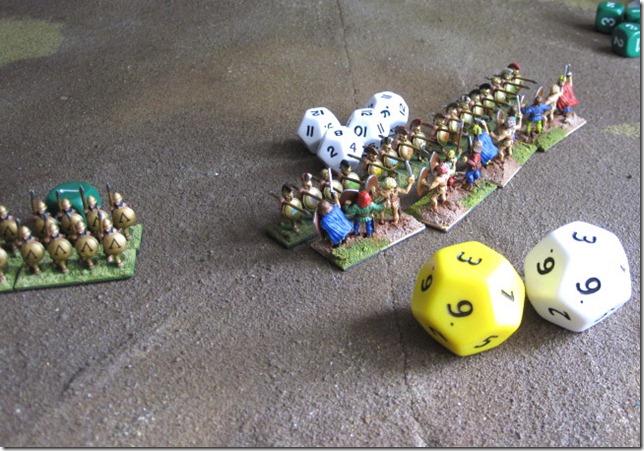
On the right, the Gauls fighting the allied Greeks cause 2 wounds for no loss. The Greeks would have needed 4’s or less to score a hit because they have no supporting rank.However the Greeks morale is fine and they are just recoiled by being beaten by 2:1 and also lose the benefit of the phalanx formation (having been recoiled).
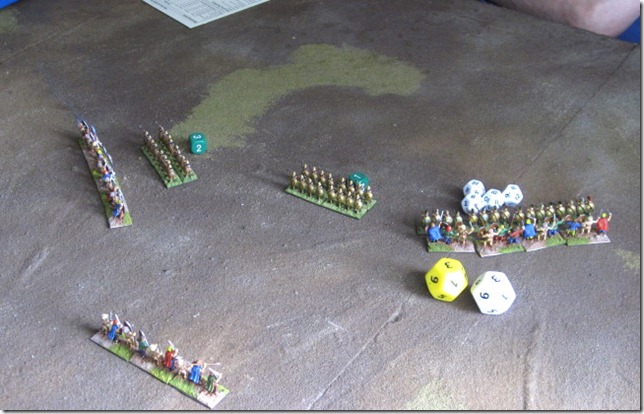
The overall view, in the centre the Gallic unit has been heavily damaged and continues to retreat, on the left the Gauls are falling back but still quite intact, whilst on the right the Gauls are winning against the allied hoplites.

Another round of combat on the right and the Gauls score 5 hits out of 8 dice rolled. The Greeks only score one hit (the one), so are beaten by 5:1.
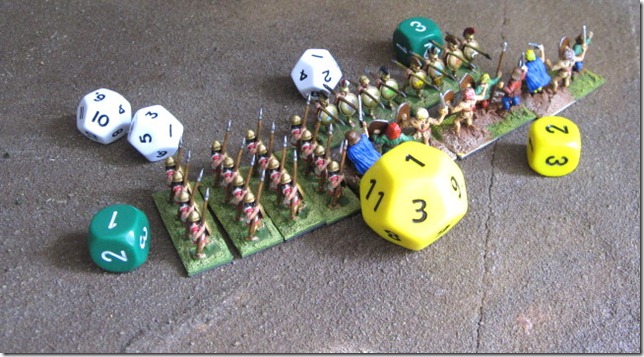
The Greeks rolled well and held but are now below 50% strength, so can never be considered better than Shaken and are spent as an offensive unit. The centre unit of Spartans charges into the flank of the Gauls. The result is 3:1 to the Spartans/Greeks and the allied hoplites have been saved from destruction.
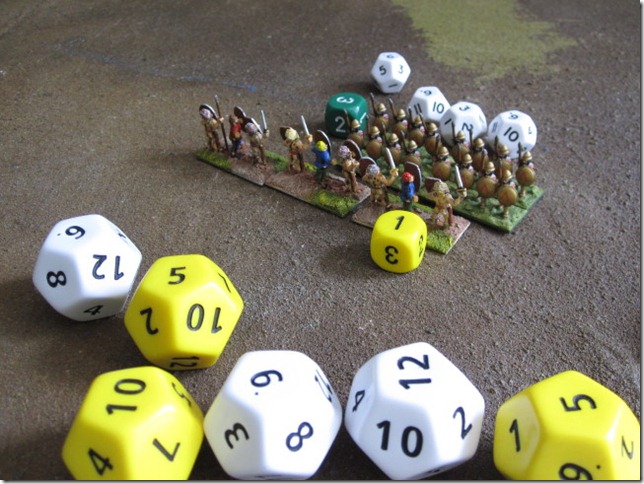
On the left the other Spartans charge into the now rallied Gauls and score 4 hits (needing 7’s as they are superior troops with the support of an rank) and the Gauls score nothing. Result the Gauls are broken and run.
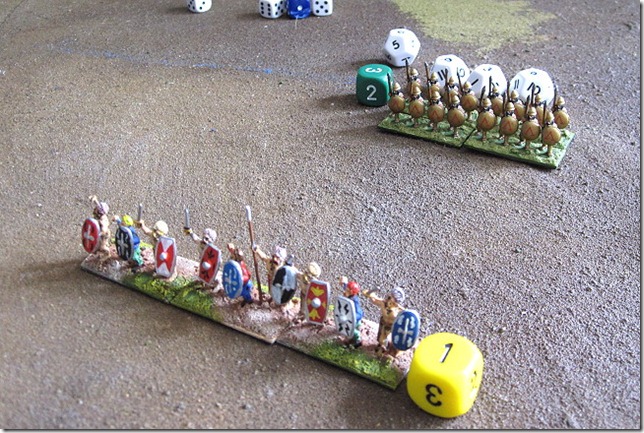
Game over. But remember this game was played with equal numbers of elements. If this had been done with armies using a points system then there would have been twice as many Gauls and the game could have gone very differently.
For more details of the Die is Cast rules, please follow the link to the Veni Vidi Vici website where a playtest version is freely downloadable.




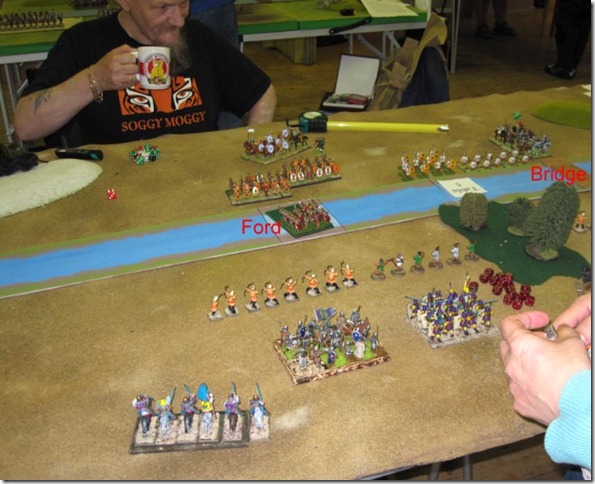
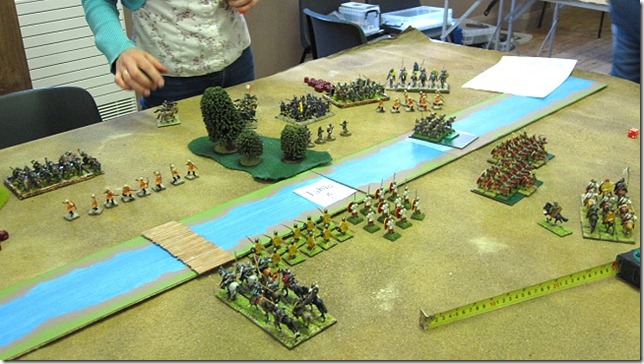
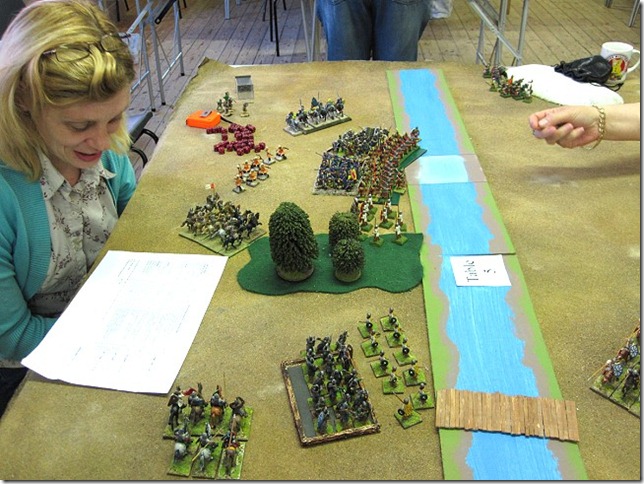
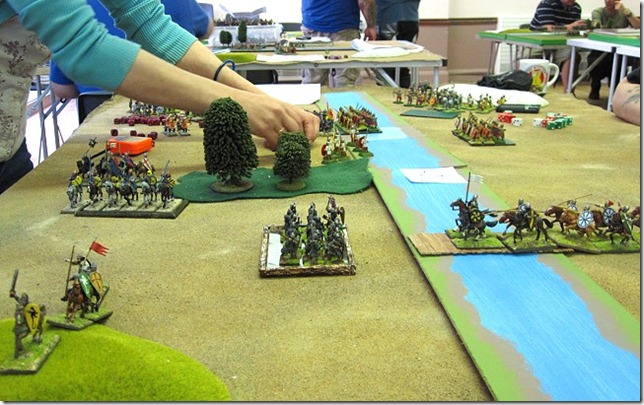
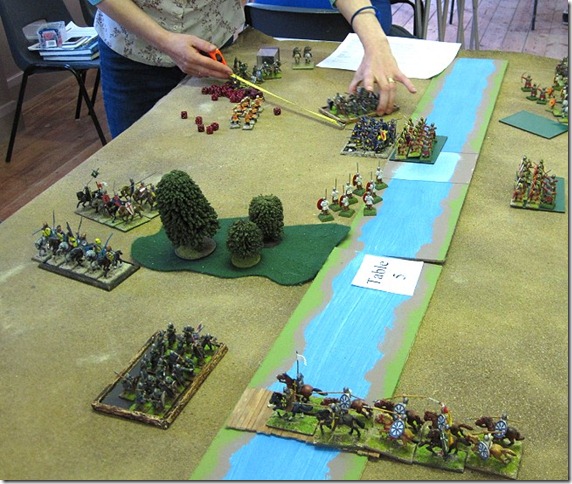
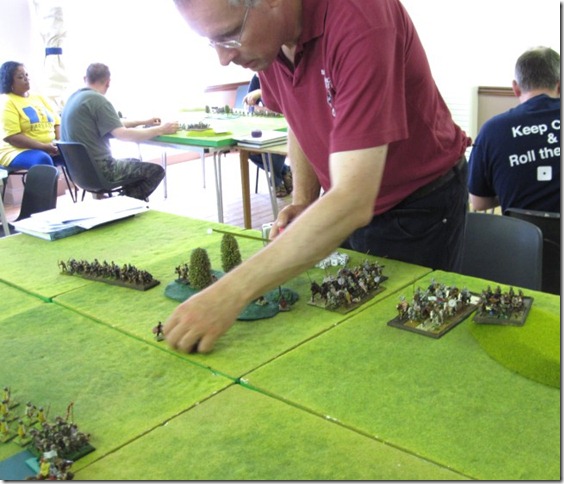
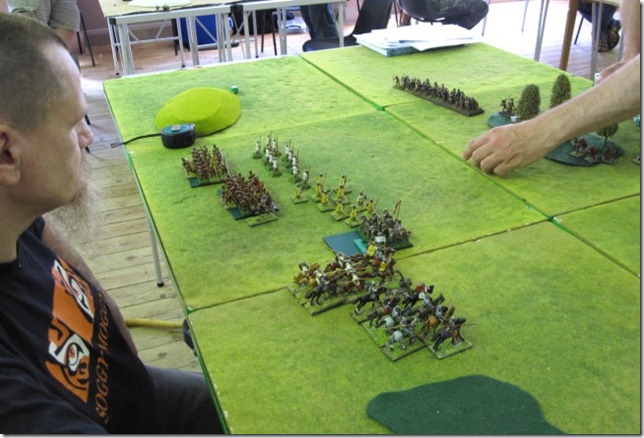

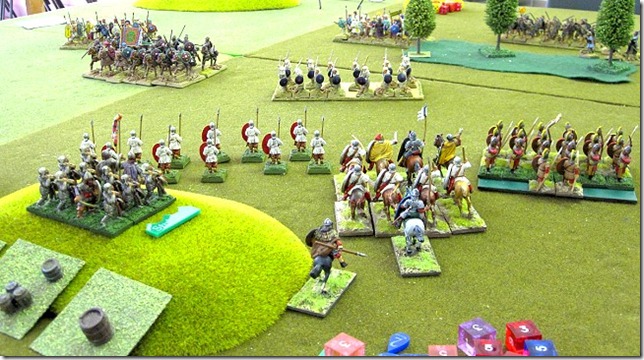
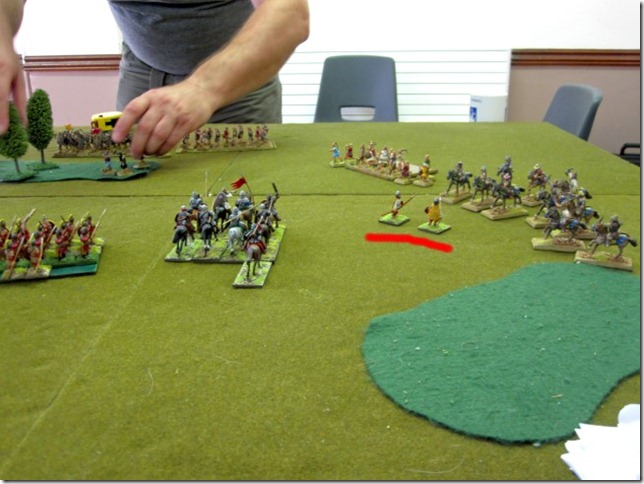
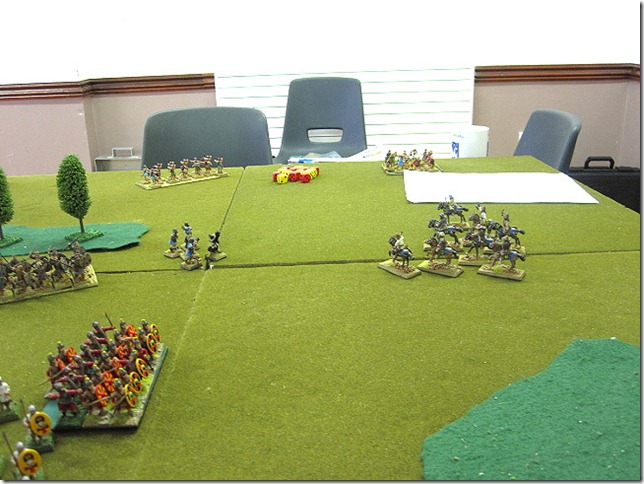
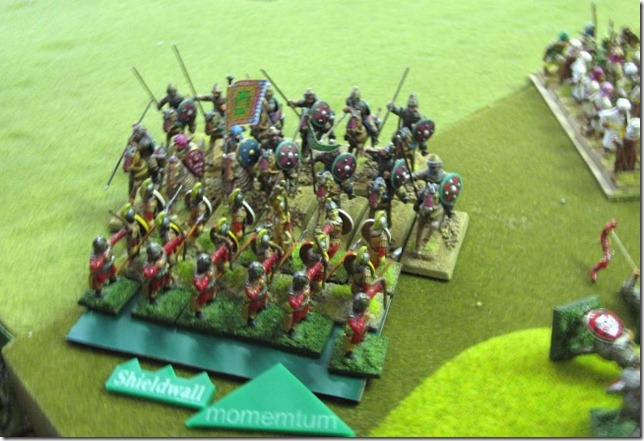
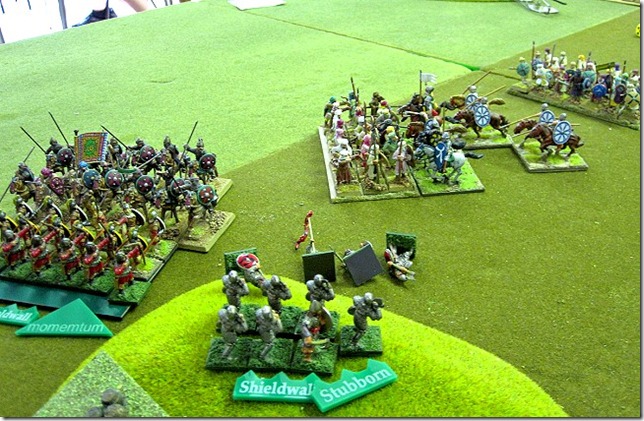
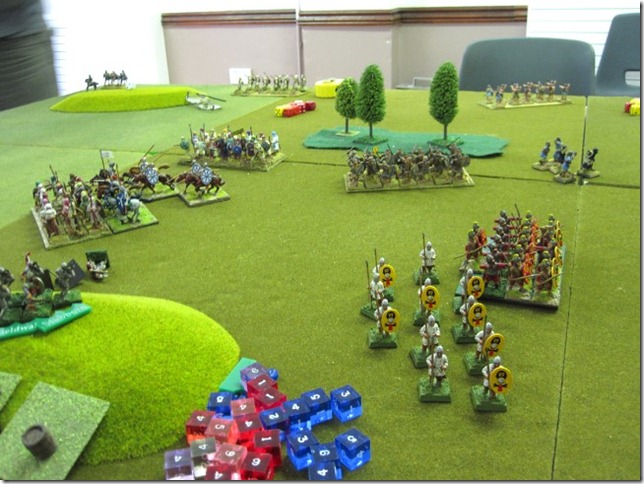
![021111_01[1] 021111_01[1]](http://lh5.ggpht.com/-bwj05ZvZpBs/UBpaHVCpy3I/AAAAAAAAAew/c0Deye0Edq8/021111_01%25255B1%25255D%25255B2%25255D.jpg?imgmax=800)
![021111_02[1] 021111_02[1]](http://lh3.ggpht.com/-qJ11cocYSgM/UBpbwTWjvmI/AAAAAAAAAfA/VIajlMJNGv0/021111_02%25255B1%25255D%25255B2%25255D.jpg?imgmax=800)
![021111_03[1] 021111_03[1]](http://lh5.ggpht.com/-QAmkeGcUoHA/UBpbxNAWlZI/AAAAAAAAAfI/YfAZdd9b2H8/021111_03%25255B1%25255D%25255B2%25255D.jpg?imgmax=800)
![021111_04[1] 021111_04[1]](http://lh3.ggpht.com/-aORpw00-c0k/UBpbyYePglI/AAAAAAAAAfQ/H2bv5Yd7a3A/021111_04%25255B1%25255D%25255B2%25255D.jpg?imgmax=800)
![021111_05[1] 021111_05[1]](http://lh3.ggpht.com/-6M2KXObhXsU/UBpbzZp36PI/AAAAAAAAAfY/x4Xo7tkIRQI/021111_05%25255B1%25255D%25255B2%25255D.jpg?imgmax=800)
![021111_06[1] 021111_06[1]](http://lh3.ggpht.com/-1zXxoBiJWrU/UBpb0DyUbhI/AAAAAAAAAfg/IBszfyn5HrE/021111_06%25255B1%25255D%25255B2%25255D.jpg?imgmax=800)
![021111_07[1] 021111_07[1]](http://lh5.ggpht.com/-1tdRc82Hf5U/UBpb1CNKZLI/AAAAAAAAAfo/3roaW_xkTi8/021111_07%25255B1%25255D%25255B2%25255D.jpg?imgmax=800)
![boltonshop_01[1] boltonshop_01[1]](http://lh3.ggpht.com/-U77AJy2q7m0/UBpb2ETEp2I/AAAAAAAAAfw/8GciI4el9kA/boltonshop_01%25255B1%25255D%25255B2%25255D.jpg?imgmax=800)
![boltonshop_02[1] boltonshop_02[1]](http://lh4.ggpht.com/-hCvyAWkUVR8/UBpb3JGdrmI/AAAAAAAAAf4/vMhgVPWNqws/boltonshop_02%25255B1%25255D%25255B2%25255D.jpg?imgmax=800)
![zulu01[1] zulu01[1]](http://lh5.ggpht.com/-Jcy_ezmVFR8/UBpWocpd8OI/AAAAAAAAAcc/7Izs5mtADes/zulu01%25255B1%25255D%25255B2%25255D.jpg?imgmax=800)
![020811_01[1] 020811_01[1]](http://lh3.ggpht.com/-EtBrcr4IvcE/UBpWpJhg_dI/AAAAAAAAAcg/kO-ybFdw4to/020811_01%25255B1%25255D%25255B2%25255D.jpg?imgmax=800)
![020811_02[1] 020811_02[1]](http://lh4.ggpht.com/-vH5Jt1tjYV0/UBpWqDtRvoI/AAAAAAAAAcs/97sy0h8WZuE/020811_02%25255B1%25255D%25255B2%25255D.jpg?imgmax=800)
![020811_03[1] 020811_03[1]](http://lh6.ggpht.com/-4ndINXKU6no/UBpWq5wovQI/AAAAAAAAAc0/BZmXWGeA3ZU/020811_03%25255B1%25255D%25255B2%25255D.jpg?imgmax=800)
![020811_04[1] 020811_04[1]](http://lh4.ggpht.com/-ysRLlIQWdpE/UBpWr8oadzI/AAAAAAAAAc8/xPlX5IlX4Pg/020811_04%25255B1%25255D%25255B2%25255D.jpg?imgmax=800)
![020811_05[1] 020811_05[1]](http://lh6.ggpht.com/-uIlJ6gDPaDU/UBpWtB77ozI/AAAAAAAAAdE/LjAUO0TnVtQ/020811_05%25255B1%25255D%25255B2%25255D.jpg?imgmax=800)
![020811_06[1] 020811_06[1]](http://lh4.ggpht.com/-4hbRkzS4ik8/UBpWuWPkAZI/AAAAAAAAAdM/WpPI2_f63M8/020811_06%25255B1%25255D%25255B2%25255D.jpg?imgmax=800)
![020811_07[1] 020811_07[1]](http://lh4.ggpht.com/-AFauyszXlJQ/UBpWvofLQ8I/AAAAAAAAAdU/AhGE4FVNRQY/020811_07%25255B1%25255D%25255B2%25255D.jpg?imgmax=800)
![020811_08[1] 020811_08[1]](http://lh4.ggpht.com/-7cU7We9L3s8/UBpWxadIwgI/AAAAAAAAAdc/_8ZS8LrsoMI/020811_08%25255B1%25255D%25255B2%25255D.jpg?imgmax=800)
![020811_09[1] 020811_09[1]](http://lh4.ggpht.com/-zh-6CZx4Jsw/UBpWyTzYMOI/AAAAAAAAAdk/ffnPTTVrxho/020811_09%25255B1%25255D%25255B2%25255D.jpg?imgmax=800)
![020811_10[1] 020811_10[1]](http://lh6.ggpht.com/-IRONtjJyJeM/UBpWzWwCPiI/AAAAAAAAAds/ywQpgZlsc6Q/020811_10%25255B1%25255D%25255B2%25255D.jpg?imgmax=800)
![020811_11[1] 020811_11[1]](http://lh3.ggpht.com/-tkL9yzTAUSg/UBpW0WtfKtI/AAAAAAAAAd0/s8sr7Qqnyo8/020811_11%25255B1%25255D%25255B2%25255D.jpg?imgmax=800)
![020811_12[1] 020811_12[1]](http://lh4.ggpht.com/-Kik8LHYr2sk/UBpW16UGVVI/AAAAAAAAAd8/eKxMRbMqm9M/020811_12%25255B1%25255D%25255B2%25255D.jpg?imgmax=800)
![020811_13[1] 020811_13[1]](http://lh3.ggpht.com/-XnoY2KqibDQ/UBpW3FyE7vI/AAAAAAAAAeE/XPyCMA7-TD4/020811_13%25255B1%25255D%25255B2%25255D.jpg?imgmax=800)
![020811_14[1] 020811_14[1]](http://lh5.ggpht.com/-AAOTaegnf0I/UBpW3_nH4wI/AAAAAAAAAeM/w1vB0lF6JPg/020811_14%25255B1%25255D%25255B2%25255D.jpg?imgmax=800)
![020811_15[1] 020811_15[1]](http://lh5.ggpht.com/-_7JRMgRcV2Y/UBpW460DrcI/AAAAAAAAAeU/2WusvgethzI/020811_15%25255B1%25255D%25255B2%25255D.jpg?imgmax=800)
![020811_16[1] 020811_16[1]](http://lh3.ggpht.com/-0n52p0kg5fA/UBpW6hnyv6I/AAAAAAAAAec/XppOyT6HGW0/020811_16%25255B1%25255D%25255B2%25255D.jpg?imgmax=800)